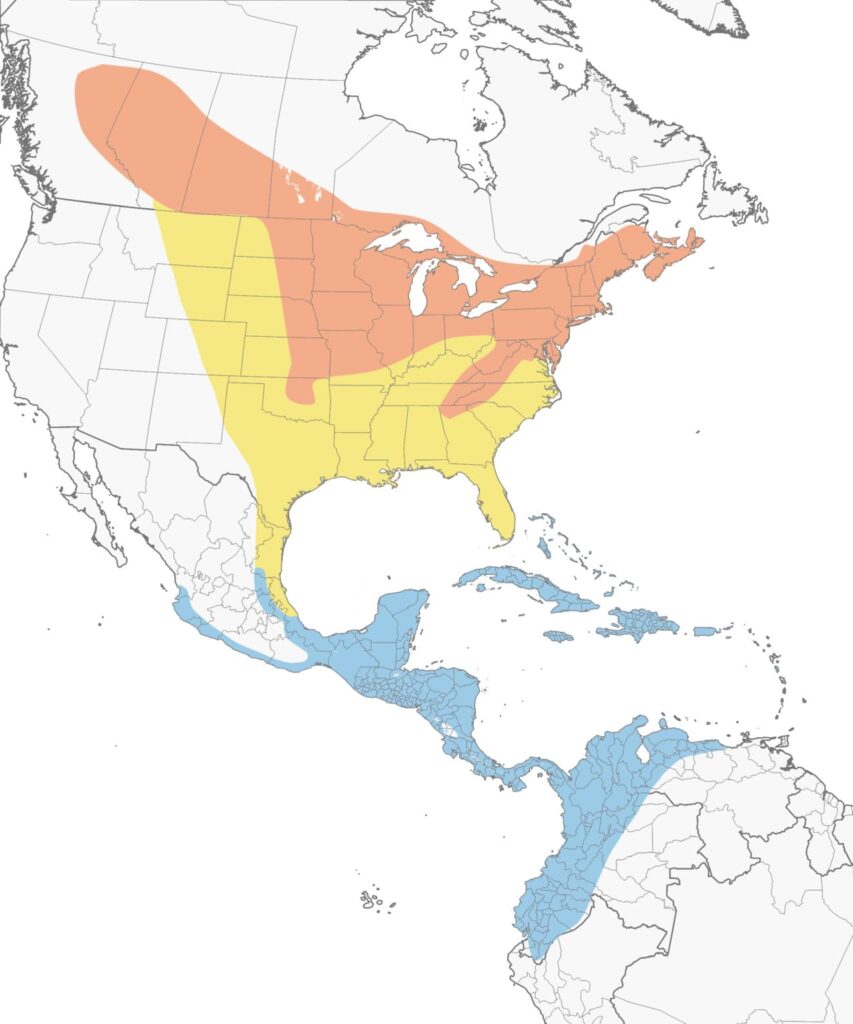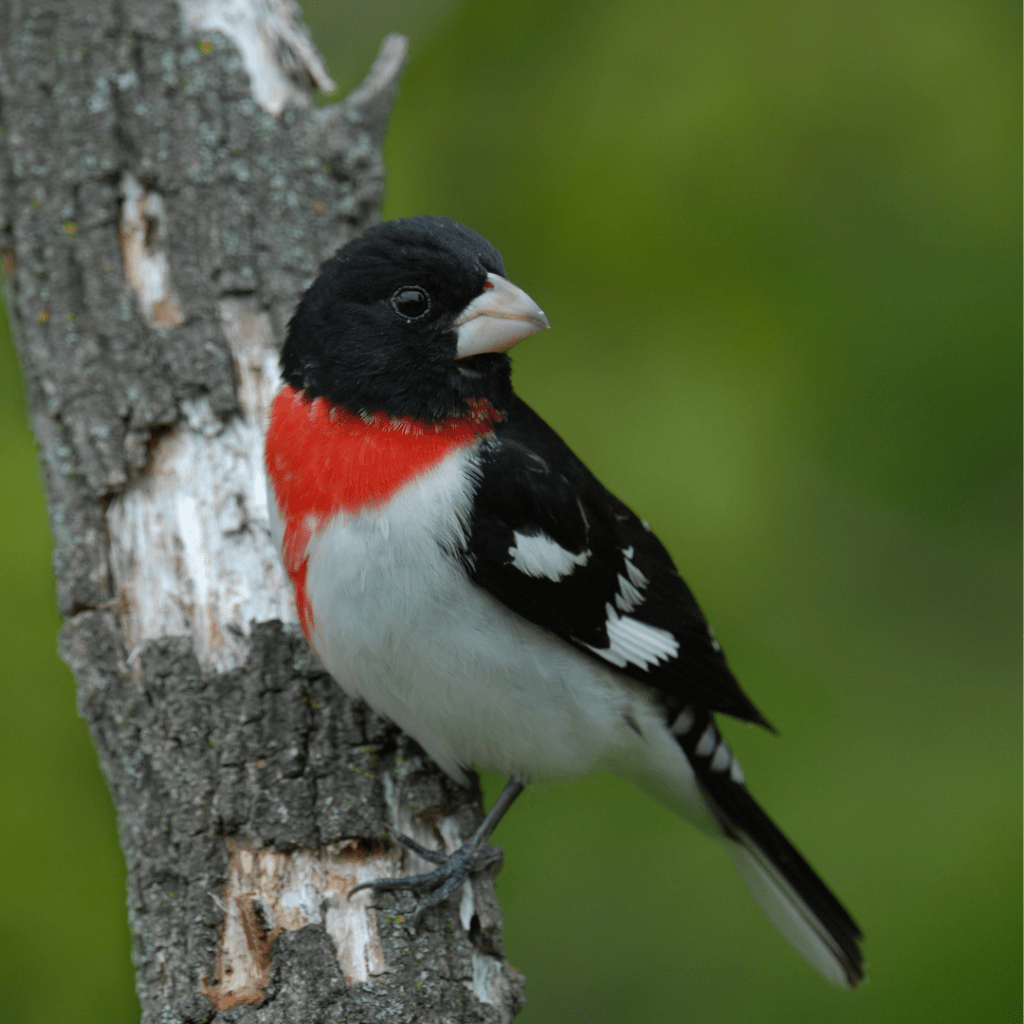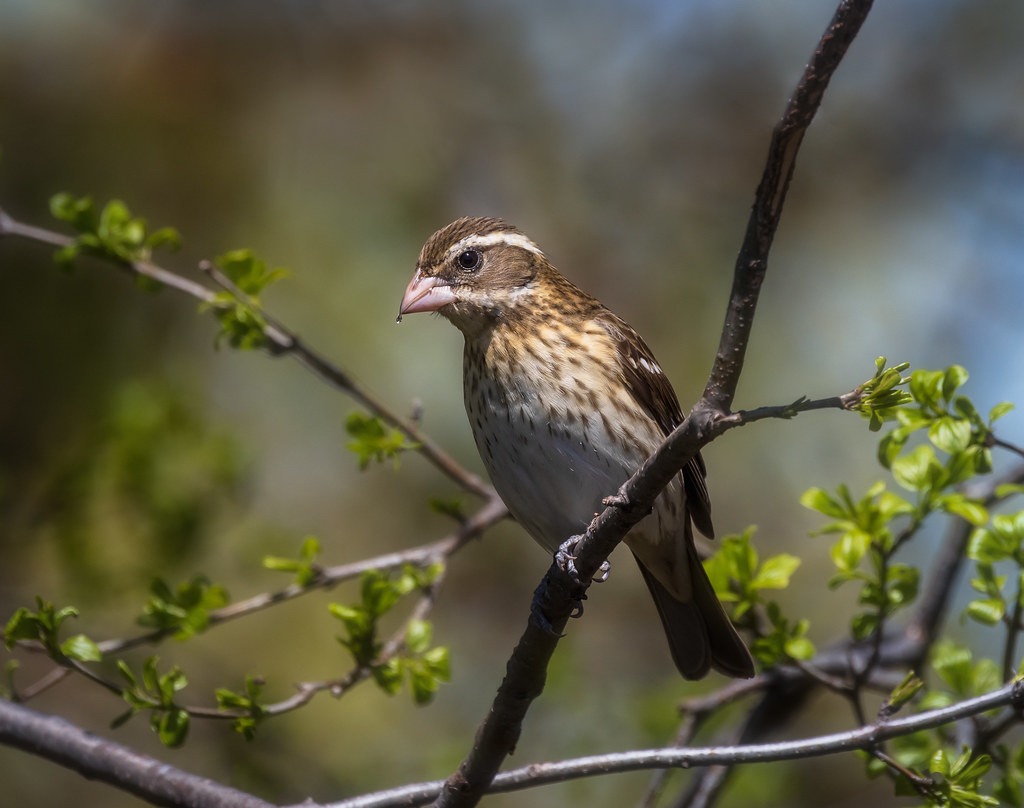Have you seen a black and white bird with a red chest? Well, it is most likely a Rose-Breasted Grosbeak! These little birds can be found all over North America ranging from southern Canada all the way to the tip of South America!
The rose-breasted grosbeak is an attractive songbird with distinctive black, white, and red plumage. “RBGs” are known for their beautiful colors, thick triangular bills, and delightful singing.
Let’s learn all about this plump member of the Cardinalidae family, including:
- Rose-breasted grosbeak basic facts
- Rose-breasted grosbeak habitat and distribution
- How to identify male and female rose-breasted grosbeaks
- What sounds do rose-breasted grosbeaks make?
- Other birds with black, white, and red color patterns
- Do rose-breasted grosbeaks visit backyard bird feeders?

Rose-Breasted Grosbeak Basic Facts
Rose-breasted grosbeaks (Pheucticus ludovicianus) are medium-sized migratory songbirds.
RBGs are one of the six grosbeak species that make up the Pheucticus genus. This genus is part of the Cardinalidae family, along with cardinals, tanagers, buntings, and others.
Rose-Breasted Grosbeak Habitat and Distribution
Rose-breasted grosbeaks are long-distance migrants. Summers are spent in the eastern US and Canada. In August or September, RBGs head south to Mexico, Central and South America, and the Caribbean.
The summer breeding range covers the American Northeast and Midwest and a long strip of southern Canada. In the US, the breeding range extends as far south as Oklahoma, Georgia, and South Carolina and as far west as the Dakotas.
During migration, RBGs occur throughout the eastern US and as far west as Montana and Wyoming. However, they travel quickly—many fly across the Gulf of Mexico in a single night.
The primary habitat types for rose-breasted grosbeaks are deciduous woods and the edges of forests. Nests are usually built 5–20 feet high in large shrubs or deciduous trees.
RBGs prefer mixed woods habitats, rather than the heart of a dense old-growth forest. They can be spotted in semi-wild settings like parks, orchards, and woodsy suburban neighborhoods.

Identifying Male and Female Rose-Breasted Grosbeaks
Among songbirds, rose-breasted grosbeaks are considered medium-sized. They’re larger than house finches and slightly smaller than robins, reaching lengths of up to 8.3 inches.
An RBG has a stocky frame and a short neck.
Grosbeaks are named for their jumbo-sized bills—grosbeak is a partial translation of the French grosbek, meaning large beak.
The large bills of RBGs and other grosbeaks are cone-shaped and built for cracking open seeds.
What Does a Male Rose-Breasted Grosbeak Look Like?
As with most songbird species, rose-breasted grosbeak males are more colorful than females.
The male color pattern consists of:

The colors are vibrant and clearly separated.
Male RBGs stand out in a crowd and aren’t typically confused with any other species. However, in the Great Plains region, RBGs sometimes hybridize with black-headed grosbeaks, producing offspring that look like either species or like an intermediate combo of the two.
What Does a Female Rose-Breasted Grosbeak Look Like?
Male and female rose-breasted grosbeaks display entirely different color patterns, although immature males may resemble mature females.
Females are gray-brown underneath with dark brown streaking. The head, wings, and tail are dark brown, with bits of white on the wings.
Where males flash red under the wings, females display a patch of yellow that can be seen from below during flight.

A white stripe that runs above the eyes towards the back of the head—called a supercilium—provides the most useful identification clue for female RBGs.
Female rose-breasted grosbeaks are most easily confused with female purple finches. In fact, the two species appear nearly identical at first glance. The differences are subtle, but include the following:
- Rose-breasted grosbeaks are larger (nearly robin-sized) than purple finches (sparrow-sized)
- A purple finch has thicker breast streaking but a less pronounced supercilium
- A purple finch’s bill is gray and an RBG’s bill is pinkish
Small brown female birds are often incredibly tricky to ID. Fortunately, grosbeaks form strong monogamous bonds and couples spend lots of time together. Where there’s a female, there’s often a male mate nearby to help you be sure of what species you’re looking at.
What Sounds Do Rose-Breasted Grosbeaks Make?
Rose-breasted grosbeaks are known for their delightful singing.
The whistled song of an RBG is similar to a robin’s song but considered sweeter and more complex.
An RBG tune contains many notes strung together in extended bursts. A song can last for six seconds, during which up to 20 individual notes are sounded.
From nature cinematographer and sound recordist Lang Elliott, here’s a beautiful example of a male rose-breasted grosbeak singing:
Do Rose-Breasted Grosbeaks Visit Backyard Bird Feeders?
Rose-breasted grosbeaks aren’t as abundant or widespread as some common backyard birds, but they do visit bird feeders.
RBGs eat seeds, insects, and fruit. During migration, they’re especially attracted to berries, providing savvy backyard birders with the chance to lure them in for a pit stop.
Here are the top options for attracting rose-breasted grosbeaks to your feeding area:
- Sunflower seeds
- Safflower seeds
- Raw peanuts
- Berries
RBGs require a large platform or hopper-style feeder that provides plenty of room to perch. They’re more likely to visit woodsy yards with lots of trees and shrubs, especially berry-producing plants like elderberry and blackberry.
Rose-breasted grosbeaks are a delight to observe and listen to, ranking among the most cherished feeder visitors for backyard birders.
Other Birds with Black, White, and Red Plumage
Did you spot a black, white, and red bird that wasn’t a rose-breasted grosbeak? The bird that you’re trying to ID is likely a type of woodpecker.
These woodpecker species all display black, white, and red plumage:
- Red-headed Woodpecker
- Red-bellied Woodpecker
- Downy Woodpecker
- Pileated Woodpecker
Woodpeckers and grosbeaks are easy to tell apart. The species listed above are all larger than red-breasted grosbeaks, closer to crow-sized. They also have longer, thinner bills that are designed for drilling into trees rather than cracking open seeds.

James has always been an avid outdoorsman. Since a kid, he kept a journal of all the different birds and species he saw. Now he wants to share his passion with other birders with Happy Birding!
